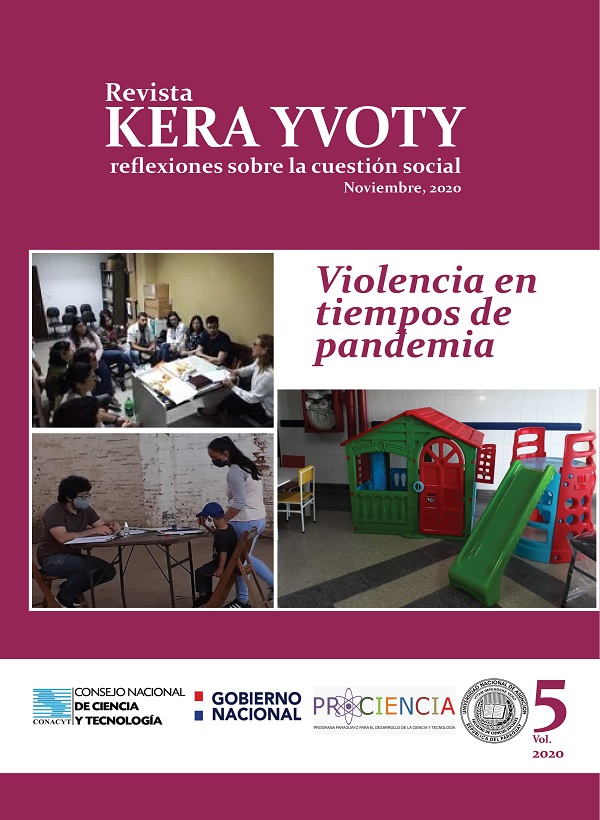Abstract
The objective of this research was to determine the opinions that the health personnel of a tertiary hospital have on child abuse. The study was observational, descriptive, temporally prospective, with non-probabilistic sampling of consecutive cases. Health personnel who provided services at the Hospital de Clínicas of the National University of Asunción were surveyed using a standardized questionnaire. 77 professionals were interviewed. With regard to the results regarding beliefs about children, the options “not showing affection” and “not meeting their basic needs” were significantly more serious for women. Regarding beliefs related to parents, the behaviors most observed in daily life were “yelling” and “threats”. Regarding the severity and frequency of the behavior, it was observed that the highest agreement was that “parents who use drugs are more likely to abuse their children.” In order to face the problem of child abuse, from the public health sphere, it is essential to know if professionals have enough tools and knowledge to address this situation, and to establish plans to improve said knowledge. In Paraguay, child abuse is not uncommon. Neglect or abandonment is the most frequent abuse, followed by sexual abuse.
References
Ackner, S., Skeate, A., Patterson, P., & Neal, A. (2013). Emotional Abuse and Psychosis: A Recent Review of the Literature. J Aggress Maltreatment Trauma, 22(9), 1032–49.
Adams, J., Mrug, S., & Knight, D. C. (2018). Characteristics of child physical and sexual abuse as predictors of psychopathology. Child Abuse Negl., 86, 167–77.
Arrom Suhurt, C. H., Arce Ramírez, A.C, Arrom Suhurt, C. M., Fresco Arrom, M. P., Samudio, M., & Capurro, M, (2015). Violencia intrafamiliar en pacientes en edad pediátrica que recibe atención psicológica. Frecuencia, factores predisponentes y consecuencias. Mem Inst Investig En Cienc Salud, 13(3), 24–30.
Dubowitz, H. (2014). Child Neglect. Pediatr Ann., 43(11), 444–5.
Finkelhor, D., Turner H, Ormrod R, Hamby SL. (2009) Violence, Abuse, and Crime Exposure in a National Sample of Children and Youth. Pediatrics., 124(5), 1411–23.
Gibb, B. E., Chelminski, I., & Zimmerman, M. (2007) Childhood emotional, physical, and sexual abuse, and diagnoses of depressive and anxiety disorders in adult psychiatric outpatients. Depress Anxiety., 24(4), 256–63.
Hamilton, J. L., Shapero, B. G., Stange, J. P., Hamlat, E. J., Abramson, L. Y., & Alloy, L. B. (2013). Emotional Maltreatment, Peer Victimization, and Depressive versus Anxiety Symptoms During Adolescence: Hopelessness as a Mediator. J Clin Child Adolesc Psychol., 42(3), 332–47.
Kairys, S. (2020). Child Abuse and Neglect. Pediatr Clin North Am., 67(2), 325–39.
Mennen, F. E., Kim, K., Sang, J., & Trickett, P. K. (2010) Child neglect: Definition and identification of youth’s experiences in official reports of maltreatment. Child Abuse Negl., 34(9):647–58.
Migliorisi, L. Z., González, E., & Almirón, L. P. (2009). Maltrato Infantil: Experiencia Multidisciplinaria Unidad de Salud Mental Hospital General Pediátrico Niños de Acosta Ñú. Pediatría Asunción, 36(3):190–4.
Mulder TM, Kuiper KC, van der Put CE, Stams G-JJM, Assink M (2018). Risk factors for child neglect: A meta-analytic review. Child Abuse Negl.;77:198–210.
Robaina, S. (2001). El maltrato infantil. Rev Cuba Med Gen Integral., 17(1):74–80.
Robinson, Y. (2020). Child Abuse: Types and Emergent Issues. Child Abuse and Neglect. https://linkinghub.elsevier.com/retrieve/pii/B9780128153444000015
Taillieu TL, Brownridge DA, Sareen J, Afifi TO. (2016) Childhood emotional maltreatment and mental disorders: Results from a nationally representative adult sample from the United States. Child Abuse Negl.;59:1–12.
Trickett, P. K., Kim, K., & Prindle, J. (2011). Variations in emotional abuse experiences among multiply maltreated young adolescents and relations with developmental outcomes. Child Abuse Negl. 35(10),876–86.
Vaillancourt-Morel, M. P., Godbout, N., Sabourin, S., Briere, J., Lussier, Y., & Runtz, M. (2016). Adult Sexual Outcomes of Child Sexual Abuse Vary According to Relationship Status. J Marital Fam Ther., 42(2), 341–56.
Yoon, S., Sh,i Y., Yoon, D., Pei, F., Schoppe-Sullivan, S., & Snyder, S. M. (2020). Child Maltreatment, Fathers, and Adolescent Alcohol and Marijuana Use Trajectories. Subst Use Misuse., 55(5), 721–33.
Zelaya de Migliorisi L, Piris de Almirón L, Migliorisi B (2012). Intentos de suicidio en niños y adolescentes. ¿Máscara de Maltrato Infantil? Pediatría Asunción; 39(3):167–72.

This work is licensed under a Creative Commons Attribution 4.0 International License.
Copyright (c) 2020 https://creativecommons.org/licenses/by/4.0




